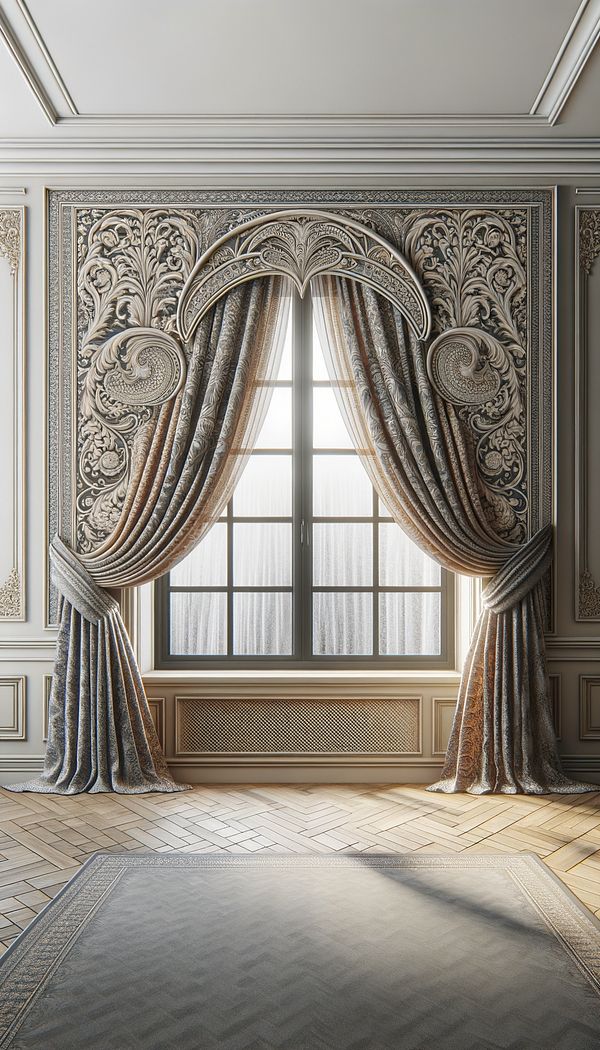What is a Lambrequin?
A lambrequin is a kind of decorative drapery or wood paneling that extends down the sides of a window or arch, often used in conjunction with curtains or blinds.
Description
A lambrequin is a unique and ornamental element in the realm of interior design, particularly within the context of window treatments. Originating from the French word "lambrequin," which historically referred to a piece of protective cloth worn over a helmet in medieval times, the term has transitioned over centuries to define an elegant decorative feature in homes and other spaces. Unlike traditional curtains or blinds, a lambrequin extends vertically down the sides of a window or archway, sometimes covering the upper part of the wall, adding both architectural interest and a sense of grandeur to a space. While often confused with a valance, a lambrequin is more structured and extends further down the window, often reaching to the sill or beyond. It can be made from various materials, including fabric that is stiffened to hold its shape or even carved wood, each providing a different aesthetic and feel to the room. Lambrequins can incorporate intricate designs, such as detailed woodwork or fabric patterns, embellishments, and even themes that align with the overall design style of the room or home. This window treatment can serve several purposes beyond its decorative appeal. It can help frame a window, creating a focal point within the room, as well as conceal drapery hardware, providing a cleaner look. Moreover, for functional purposes, lambrequins can assist in controlling light and enhancing privacy. Their use isn't just limited to residential settings but can be found in commercial spaces, historic buildings, and elegant hotels, demonstrating their versatility and enduring appeal.
Usage
In traditional or classical interior designs, lambrequins often feature heavily embellished fabric or ornate wooden carvings to complement the overall aesthetic of the space. They are particularly popular in settings that aim for a luxurious or historical ambiance, such as Victorian, Baroque, or Rococo themed rooms. However, modern interpretations can also be found in minimalistic designs where simplified versions add depth and interest to the windows without overwhelming the space. In commercial settings, lambrequins might be used to enhance the sophistication of boutique hotels, high-end restaurants, or luxurious spas, serving both an aesthetic and functional role in managing light and ensuring privacy.
FAQs
-
Are lambrequins outdated?
No, while lambrequins are rooted in historical design, they have evolved and can be adapted to fit both classical and contemporary interiors, making them a versatile design element.
-
Can lambrequins be used in all types of rooms?
Yes, lambrequins can be utilized in a variety of settings, from living rooms and dining spaces to bedrooms and commercial environments, offering both decorative and functional benefits.
-
Do lambrequins require custom fabrication?
Typically, yes. Due to their detailed and often intricate designs, lambrequins are usually custom-made to fit specific window dimensions and design preferences.
-
Are there any functional benefits to using lambrequins?
Yes, beyond their decorative appeal, lambrequins can help in managing light, enhancing privacy, and concealing drapery hardware for a cleaner look.
Practical Application
When considering a lambrequin for your space, think about the overall theme and design aesthetic you're aiming for. A custom-designed lambrequin can significantly elevate a room's elegance and provide a unique focal point. For a harmonious look, consider the material and pattern of the lambrequin in relation to other decorative elements in the room. If you're aiming for a more contemporary setting, opt for simpler designs and materials that complement rather than overwhelm the space. Consult with a professional designer or a skilled craftsman who specializes in custom window treatments to achieve the best results.
-
Design Styles478 articles
-
Furniture Types599 articles
-
Decorative Techniques322 articles
-
Window Treatments65 articles
-
Historical Periods & Movements150 articles
-
TuscanTuscan refers to a design style inspired by the Tuscany region in Italy.
-
DecalA decal is a design prepared on a special paper for durable transfer on to another surface such as glass, metal, or ceramic.
-
GouacheGouache is a type of paint known for its opaqueness and matte finish.
-
Carlton TableA Carlton Table is a versatile piece of accent furniture characterized by its distinctive crossed-leg design.
-
MarbleizingMarbleizing is the process of applying paint or glaze to a surface to imitate the intricate patterns and colors of natural marble.
